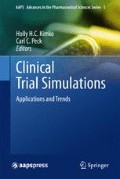Abstract
The components of a clinical trial simulation consist of the input–output model, the covariate distribution model, and the trial execution model. The input–output model consists of submodels that incorporate the drug’s pharmacokinetics and pharmacodynamics, the disease progression during the trial, the trial endpoints, and the residual variability. Some of these submodels may include covariate influences on model parameters, which comprise the covariate distribution model. Appropriate simulation of clinical trials requires appropriate simulation of covariates because generation of covariates from an invalid probability distribution may result in an inadequate distribution of the simulation output. Basically, you need the right inputs to get the right outputs. This chapter will define covariate distribution models, will show how internal and external datasets may be used to define an appropriate probability distribution, and will demonstrate how to model covariate distributions.
Access this chapter
Tax calculation will be finalised at checkout
Purchases are for personal use only
References
Aarons L, Vozeh S, Wenk M, Weiss P, Follath F (1989) Population pharmacokinetics of tobramycin. Br J Clin Pharmacol 38:305–314
Bonate PL (2006) Pharmacokinetic-pharmacodynamic modeling and simulation. Springer, New York
Chien JY, Friedrich S, Heathman M, de Alwis DP, Sinha V (2005) Pharmacokinetics/pharmacodynamics and the stages of development: role of modeling and simulation. AAPS J 7:E544–E559
Cockcroft DW, Gault MH (1976) Prediction of creatinine clearance from serum creatinine. Nephron 16:31–41
Holford NHG, Kimko HC, Monteleone JPR, Peck CC (2000) Simulation of clinical trials. Annu Rev Pharmacol Toxicol 40:209–234
Kirk RE (1982) Experimental design: procedures for the behavioral sciences. Brooks/Cole Publishing Company, Belmont
Lazo M, Selvin E, Clark JM (2008) Clinical implications of short-term variability in liver function test results. Ann Intern Med 148:348–352
Lowe PJ, Tannenbaum S, Gautier A, Jimenez P (2009) Relationship between omalizumab pharmacokinetics, IgE pharmacodynamics, and symptoms in patients with severe allergic (IgE-mediated) asthma. Br J Clin Pharmacol 68:61–76
Metropolis N (1987) The beginning of the Monte Carlo method. Los Alamos Sci 12:125–130
Savage S (2009) The flaw of averages. Wiley, New York
U.S. Department of Health and Human Services, Center for Disease Control and Prevention, National Center for Health Statistics (2007) National health and nutrition examination survey, 2007–2008. http://www.cdc.gov/nchs/data/nhanes/nhanes_07_08/overviewbrochure_0708.pdf. Accessed May 2010
Yohai VJ (1987) High breakdown point and high efficiency robust estimates for regression. Ann Statist 16:642–656
Acknowledgments
The author would like to thank Steve Weller at GlaxoSmithKline for his thoughtful comments.
Author information
Authors and Affiliations
Corresponding author
Editor information
Editors and Affiliations
Rights and permissions
Copyright information
© 2011 Springer Science+Business Media, LLC
About this chapter
Cite this chapter
Bonate, P.L. (2011). Covariate Distribution Models in Simulation. In: Kimko, H., Peck, C. (eds) Clinical Trial Simulations. AAPS Advances in the Pharmaceutical Sciences Series, vol 1. Springer, New York, NY. https://doi.org/10.1007/978-1-4419-7415-0_22
Download citation
DOI: https://doi.org/10.1007/978-1-4419-7415-0_22
Published:
Publisher Name: Springer, New York, NY
Print ISBN: 978-1-4419-7414-3
Online ISBN: 978-1-4419-7415-0
eBook Packages: Biomedical and Life SciencesBiomedical and Life Sciences (R0)


